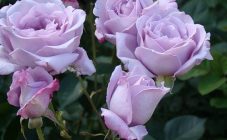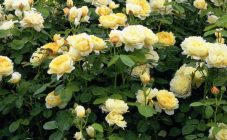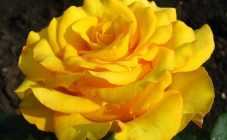Content:
Well-known to gardeners, the rose Alan Souchon belongs to hybrid tea crops, often called Rouge Royal (in French) or Caruso. The main name of this flower was given in honor of the famous French actor Alain Souchon, who highly appreciated the bouquets of this variety.
History of creation
It is known that alain souchon rose as a variety was bred in the French province of Maeiland in 2000. It was obtained by crossing two popular species: Ambassador plus Fiorella. After its appearance, this plant joined the famous collection of the Meilland International company, specializing in the cultivation of roses.
Description and characteristics
The smell of the alan variety is so rich that it is almost impossible to distinguish its shades the first time. It partially contains not only strawberry, but also slightly perceptible anise and fresh raspberry aromas. This variety retains its decorative properties for a long time (12-14 days). Its bush is completely covered with beautiful and fresh flowers during the entire flowering period.
The abundantly growing inflorescences of the rose Alain Souchon, or alain souchon, are distinguished by high frost resistance. They are quite resistant to drought, but with prolonged exposure to sunlight, rose petals can be damaged. At normal temperatures, flowering continues throughout the season without any problems.
A detailed description of the Alain Souchon rose can be reduced to the following features of the shape and characteristics of its inflorescences, namely:
- The bud of this plant has a classic configuration, according to which the petals are tightly pressed against one another and are strictly normalized in size.
- The flowers in this garden variety are blood red, but there are many shades, such as purple, cherry or pomegranate.
- The finally formed culture has a neat appearance with vertical shoots and light green foliage with a tint of glossiness.
- During flowering, the height of the bushes can reach an indicator of the order of 90-100 cm, in width - about 80 cm.
Due to the long-term preservation of decorative properties, the hybrid tea variety of roses is widely used in the design of a wide variety of bouquets. The bush of this culture is quite compact and strictly formed; the average size of individual inflorescences can be up to 13 centimeters.
Without reliable shelter, these garden plants can overwinter at average temperatures of the order of minus 7 degrees. In colder winters, they need mandatory protection.
Agrotechnics
Disembarkation
On the site for planting a hybrid rose Alan Souchon, there should be enough sunlight with the possibility of partial shading. It also provides conditions for natural air circulation, but strong drafts are unacceptable.
The specified variety of roses grows well on weakly acidic fertile soils with good air permeability, which provides the roots of the plant with the necessary amount of oxygen.
Its planting is usually started early in the spring, around April or May. It boils down to performing the following mandatory procedures:
- First, a hole is prepared for the rose bush, approximately 60 cm deep.
- After that, drainage is laid on its bottom in the form of small rubble stones, at least 10 cm thick.
- On top of this layer, organic matter is applied, which is usually compost or rotted manure (their thickness is the same as that of the drainage).
- Further, a mound of garden soil is poured into the hole.
During planting, the root collar after compaction of the soil should be located slightly below ground level. This arrangement guarantees the appearance of additional shoots appearing above the graft point. At the end of planting work, the bush is abundantly spilled with water warmed up in the sun, after which the soil around it is mulched with peat.
Rose care
Seasonal care for Alan Souchon consists of weed removal, preventive treatment, as well as top dressing and timely pruning.
Top dressing is organized, depending on the season: nitrogen is added to it in spring, phosphorus or potassium in summer. For systematic watering of the plant, heated water in the amount of 15-20 liters per bush should be used. By the end of the summer season, the intensity of irrigation is noticeably reduced and completely stops with the arrival of September.
The best time for pruning roses is early spring, when buds swell on the bushes. During this period, about 5-7 bud sites are left on them, sufficient to preserve the decorativeness of the plant. In the summer season, the so-called. "Light" pruning, consisting in the removal of already faded inflorescences.
The autumn procedure is of a sanitary and preventive nature; at this time, only diseased or damaged shoots are usually removed, and strongly overgrown branches are thinned out.
Advantages and disadvantages
The advantages of this hybrid variety consist in the following advantages inherited from its two predecessors:
- The original form of inflorescences with a bright and rich shade.
- The flexibility of the plant's flower stem.
- Its ability to maintain its appearance for a long time.
- Good frost resistance.
In conclusion, we note that the Alan Souchon rose is one of the favorite varieties of Russian gardeners, found in most garden plots of central Russia. The guarantees of its popularity in these regions are good frost resistance and unpretentious care.















